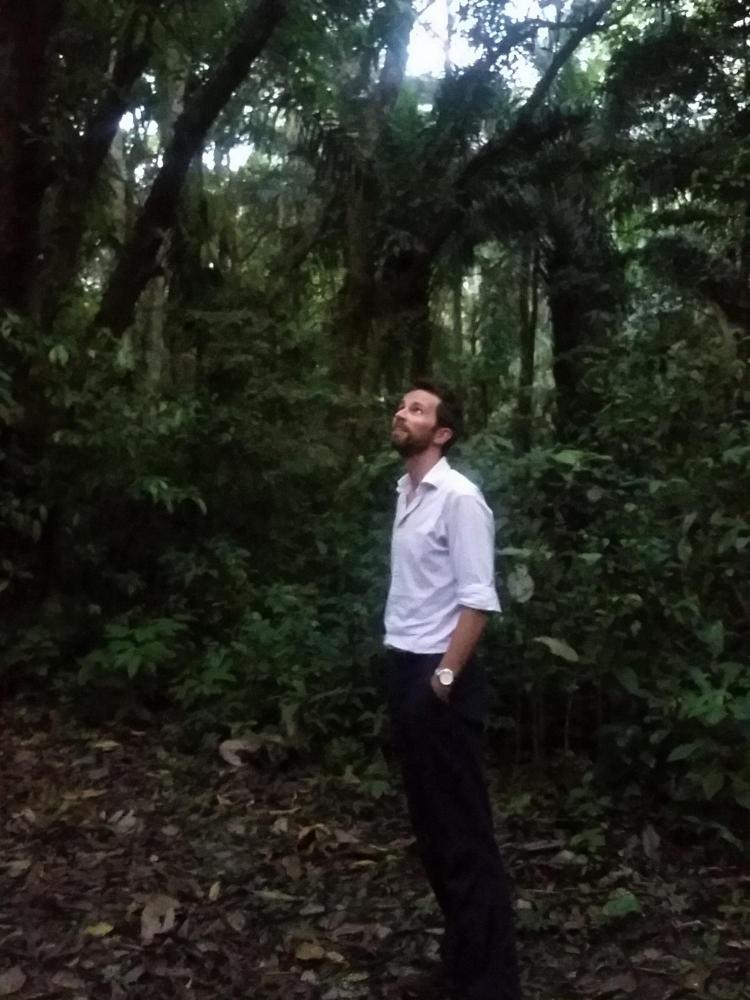Worldwide, 1.6 billion rural people live within 5 km of a forest
Study led by CU Boulder researcher is first to tally ‘forest proximate’ humans on earth; numbers, refined terminology may improve focus of conservation and development
For decades, public development agencies, non-governmental organizations and donors have been spending countless millions of dollars on sustainable development and conservation projects to improve the lives of people living in and around forests.

Together with colleagues from the Federal University of Acre, lead author Peter Newton talks with Sr. Dimas in his agroforest on the edge of the Amazonian forest in the state of Acre, Brazil.
Yet surprisingly, nobody actually knew how many such people live on the planet.
Human activity appears to be driving almost all deforestation."

Lead author Peter Newton in the Amazonian state of Acre, Brazil.
“People had made estimates of ‘forest dependence,’ but not in any empirically rigorous, consistent way,” says Peter Newton, assistant professor of environmental studies at the University of Colorado Boulder.
But thanks to Newton and four colleagues in a study out today in One Earth, that’s no longer the case. Using satellite imagery and population data, they not only arrived at a solid number, but also make the case that “forest proximity” is a more readily defined measuring stick than “dependent.”
As part of the study, researchers found that:
- Globally, some 1.6 billion of the earth’s rural inhabitants (those living in areas with fewer than 1,500 people per square kilometer) live within 5 kilometers of a forest.
- About 54% of Americans, some 169 million, were forest-proximate, about 11% of the global total.
- No forest-proximate people lived in icy Greenland or the desert nation of Kuwait.
- 76% of people in Norway and 75% in Bhutan lived near forests.
Coincidentally, the World Bank estimates that some 1.6 billion people are “forest dependent.” But the numbers actually reflect different things, Newton, the study’s lead author, says, and the researchers argue that proximity is the more easily defined concept.
“The term captures the spatial relationship between people and forests precisely, without presuming anything additional about the nature of the relationship between them,” they wrote in the study.
The idea of “forest dependent” has traditionally served as something of a proxy for people who are living in poverty in low- or middle-income countries and who rely on forests for subsistence or income, Newton says. But because forest-dependency can also include, for example, timber-industry workers in developed nations, it may be of less use when trying to improve the lives of those in need.
On the flip side, not all “forest proximate” people are “forest dependent,” presumably including most of the 169 million Americans who live near forests.
“It’s possible to live next to a forest and not really use the forest. … And it’s possible to live more than five kilometers away and have your livelihood directly tied to the forest; you might work in a lumber mill or furniture factory. Those aren’t necessarily the target populations for agencies interested in improving the lot of forest-dependent people,” Newton says, noting that as many as 80% of people in some countries use wood collected from forests for fuel.
The new study provides baseline data that can help development and conservation agencies better target funding, and to evaluate the impacts of their projects on people’s livelihoods.
In a 2016 paper published in the journal Land Use Policy, Newton and three colleagues make the case that, rather than trying to reduce forest dependency, agencies might be better off working to increase the autonomy of local people to manage forest resources.
Overall, deforestation continues to be a global problem. According to the World Bank, approximately 30.8% of earth’s land mass was forested—broadly defined as two hectares of tree cover—in 2012. The U.N. Food and Agriculture Organization of the United Nations estimates that from 2000 to 2020, global forest cover decreased by 100 million hectares, or about 2.4%.
Human activity appears to be driving almost all deforestation. Amazon forests are clear-cut to make way for cattle pastures, for example, while climate change is contributing to the increased frequency and severity of wildfires and infestation by forest-killing bark beetles; some counties in southern Colorado now estimate that up to 70% of local forests are dead or dying from beetle infestation.
“Humans can heavily influence landscapes,” says Newton, who has done extensive field work in Brazil. “Population (growth) is part of the equation, but per capita consumption, what we consume, is also part of the equation.”
“I worry about it a lot,” he says. “I’m very interested in studying the drivers of deforestation and land-use change … and studying alternative ways to produce food, more sustainable forms of cattle production, and alternative proteins with lower environmental impacts.”
Other authors on the paper include Andrew T. Kinzer of Eden Reforestation Projects; Daniel C. Miller of the University of Illinois Urbana-Champaign; Johan A. Oldekop of the University of Manchester; and Arun Agrawal of the University of Michigan.

